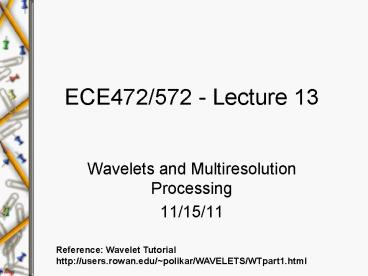ECE472/572 - Lecture 13 PowerPoint PPT Presentation
Title: ECE472/572 - Lecture 13
1
ECE472/572 - Lecture 13
- Wavelets and Multiresolution Processing
- 11/15/11
Reference Wavelet Tutorial http//users.rowan.edu
/polikar/WAVELETS/WTpart1.html
2
Roadmap
Roadmap
Preprocessing low level
Knowledge Base
3
Questions
- Why wavelet analysis? Isnt Fourier analysis
enough? - What type of signals needs wavelet analysis?
- What is stationary vs. non-stationary signal?
- What is the Heisenberg uncertainty principle?
- What is MRA?
- Understand the process of DWT
4
Non-stationary Signals
- Stationary signal
- All frequency components exist at all time
- Non-stationary signal
- Frequency components do not exist at all time
5
x(t)cos(2pi5t)cos(2pi10t)cos(2pi20t)c
os(2pi50t)
Stationary signal
Non-stationary signal
FT
6
(No Transcript)
7
Short-time Fourier Transform (STFT)
- Insert time information in frequency plot
8
Problem of STFT
- The Heisenberg uncertainty principle
- One cannot know the exact time-frequency
representation of a signal (instance of time) - What one can know are the time intervals in which
certain band of frequencies exist - This is a resolution problem
- Dilemma
- If we use a window of infinite length, we get the
FT, which gives perfect frequency resolution, but
no time information. - in order to obtain the stationarity, we have to
have a short enough window, in which the signal
is stationary. The narrower we make the window,
the better the time resolution, and better the
assumption of stationarity, but poorer the
frequency resolution - Compactly supported
- The width of the window is called the support of
the window
9
(No Transcript)
10
(No Transcript)
11
Multi-Resolution Analysis
- MRA is designed to give good time resolution and
poor frequency resolution at high frequencies and
good frequency resolution and poor time
resolution at low frequencies. - This approach makes sense especially when the
signal at hand has high frequency components for
short durations and low frequency components for
long durations. - The signals that are encountered in practical
applications are often of this type.
12
Continuous Wavelet Transform
y(t) mother wavelet
13
(No Transcript)
14
(No Transcript)
15
Application Examples Alzheimers Disease
Diagnosis
16
Examples of Mother Wavelets
17
Wavelet Synthesis
orthonormal
The admissibility condition
oscillatory
18
Discrete Wavelet Transform
- The continuous wavelet transform was computed by
changing the scale of the analysis window,
shifting the window in time, multiplying by the
signal, and integrating over all times. - In the discrete case, filters of different cutoff
frequencies are used to analyze the signal at
different scales. The signal is passed through a
series of highpass filters to analyze the high
frequencies, and it is passed through a series of
lowpass filters to analyze the low frequencies. - The resolution of the signal, which is a measure
of the amount of detail information in the
signal, is changed by the filtering operations - The scale is changed by upsampling and
downsampling operations.
19
Discrete Wavelet Transform
The process halves time resolution, but doubles
frequency resolution
gL-1-n (-1)n . hn Quadrature Mirror
Filters (QMF)
20
Examples
21
DWT and IDWT
Quadrature Mirror Filters (QMF)
IDWT
Perfect reconstruction needs ideal halfband
filters Daubechies wavelets
22
DWT and Image Processing
- Image compression
- Image enhancement
23
2D Wavelet Transforms
24
(No Transcript)
25
Example
26
Application Example - Denoising
MAD median of coefficients at the finest
decomposition scale
27
Application Example - Compression
28
(No Transcript)
29
A Bit of History
- 1976 Croiser, Esteban, Galand devised a
technique to decompose discrete time signals - 1976 Crochiere, Weber, Flanagan did a similar
work on coding of speech signals, named subband
coding - 1983 Burt defined pyramidal coding (MRA)
- 1989 Vetterli and Le Gall improves the subband
coding scheme
30
Acknowledgement
The instructor thanks the contribution from Dr.
Robi Polikar for an excellent tutorial on wavelet
analysis, the most readable and intuitive so far.
http//engineering.rowan.edu/polikar/WAVELETS/WTt
utorial.html

